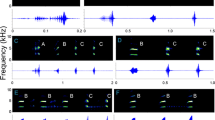Abstract
The period of calling activity ofPolypedates maculatus lies between April and October. Males possess an indistinct subgular vocal sac which turns yellow during the breeding season. Mating calls type I, type II and distress calls have been identified. Mating calls type I and type II consist of a single pulse group. Type I call comprises of 7–22 pulses, whereas type II call consists of 4–6 pulses. Pulses are short. The frequency spectrum is broad and continuous. Distress calls, with 6 hormonics, are given by the females with their mouth open.
Similar content being viewed by others
References
Bogert C M 1960 The influence of sound on the behavior of amphibians and reptiles; inAnimal and sound communication (eds) W E Lynyon and W N Tavolga (Washington: Am. Inst. Biol. Sci. Publ.) pp 137–320
Blair W E 1963 Acoustic behavior in amphibia; inAcoustic behavior of animals (ed.) R G Busnel (Amsterdam: Elsevier) pp 694–708, 803–804
Blair W E 1968 Amphibians and reptiles; inAnimal communication (ed.) T A Sebeok (Bloomington: Indiana Univ. Press) pp 289–230
Brzoska 1982 Vocal response of European water frogs (Rana esculenta complex) to mating and territorial calls;Behav. Process. 7 37–47
Capranica R R 1977 Auditory processing of vocal signals; inThe reproductive biology of amphibians (eds) D H Taylor and SI Guttman (New York: Plenum Press) pp 337–355
Duellman W E and Trueb L 1985 Vocalization; inBiology of amphibians (eds) W E Duellman and L Trueb (New York: McGraw Hill) pp 87–107
Gerhardt H C 1978 Mating call recognition in the green tree frogs (Hyla cinerea): The significance of some fine-temporal properties;J. Exp. Biol 74 59–73
Kanamadi R D and Jirnakali C S 1991 Ovarian activity in the tree frogPolypedates maculatus: A qualitative and quantitative study of ovarian cycle and its relation to oviduct and fat body cycle;Zool. Am. 226 149–162
Kanamadi R D and Jirankali C S 1992 Testicular activity inPolypedates maculatus (Rhacophoridae): Seasonal changes in spermatogenesis and fat bodies;J. Herpetol 26 329–335
Kanamadi R D and Hiremath C R 1989 Anuran amphibian fauna of Dharwad;J. Karnatak Univ. Sci. 33 8–12
Kanamadi R D, Hiremath C R and Schneider H 1992 Vocalization and breeding in South Indian tropical frogRana crassa (Jerdon);Zool. Am. 228 26–31
Kuramoto M 1975 Mating calls of Japanese tree frogs (Rhacophoridae);Bull. Fakuoka Univ. Edac. 24 66–67
Kuramoto M 1986 Call structure of the rhacophorid frogs from Taiwan;Sci. Rep. Lab. Amphibian Biol Hiroshima Univ. 8 45–68
Littlejohn M J 1977 Long range acoustic communication in anurans: An integrated and evolutionary approach; inThe reproductive biology of amphibians (eds) D H Taylor and S I Guttman (New York: Plenum Press) pp 263–294
Paillette M 1971 Communication acoustique chez les amphibians anoures;J. Psychol. Norm. Pathol. 1327–351
Rand A S 1988 An overview of anuran acoustic communication; inThe evolution of amphibian auditory system (eds) B Fritzsch, M J Ryan, W Wilczynski, T E Hetherington and W Wolkowiak (New York: John Wiley) pp 415–431
Ryan M J 1988 Constraints and patterns in the evolution of anuran acoustic communication; inThe evolution of amphibian auditory system (eds) B Fritzsch, M J Ryan, W Wilczynski, T E Hetherington and W Wolkowiak (New York: John Wiley) pp 637–677
Schiotz A 1967 The tree frogs (Rhaeophoridae) of West Africa;Spolia Zool. Mus. Hauniensis 25 1–346
Schneider H 1967 Rufe and Rufverhalten des Laubfrosches,Hyla arborea arborea (L).Z. Vql. Physiol 57 174–189
Schneider H 1971 Steuerung des taglichen Rufbeginns beim Laubfrosch,Hyla arborea arborea (L.):Oecologia 8 310–320
Schneider H 1977 Acoustic behavior and physiology of vocalization in the European tree frogHyla arborea; inThe reproductive biology of amphibians (eds) D H Taylor and S I Guttman (New York: Plenum Press) pp 295–336
Schneider H 1982 Phonotaxis bei Weibchen des Kanarischen Laubfrosches,Hyla meridionalis Zool Anz. 208 161–174
Schneider H 1990 Reproductive behavior and biology of central European water frogs; inBiology and physiology of amphibians (ed.) W Hanke (Stuttgart: Gustav Fischer Verlag) pp 29–39
Schneider H, Nevo E, Simson S and Brzoska J 1984 Auditory discrimination tests of female near estern tree frogs and reevaluation of the systematic position (Amphibia, Hylidae);Zool. Anz. 213 306–312
Schneider H, Hussein F and Akef M S A 1986 Comparative bioacoustic studies in the yellow-bellied toad,Bombina variegata (L), and relationship of European and Asian species and subspecies of the genusBombina (Anura, Amphibia);Bonn. Zool. Beitr. 37 49–67
Straughan I R 1973 Evolution of mating calls: Bioacoustical aspects; inEvolutionary biology of the anurans (ed.) J A Vial (Columbia: Univ. Missouri Press) pp 321–327
Author information
Authors and Affiliations
Rights and permissions
About this article
Cite this article
Kanamadi, R.D., Schneider, H., Hiremath, C.R. et al. Vocalization of the tree frogPolypedates maculatus (Rhacophoridae). J Biosci 18, 239–245 (1993). https://doi.org/10.1007/BF02703121
Received:
Revised:
Issue Date:
DOI: https://doi.org/10.1007/BF02703121




